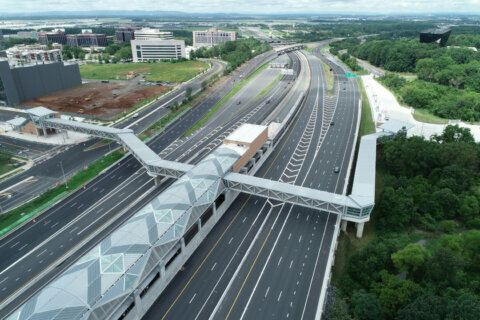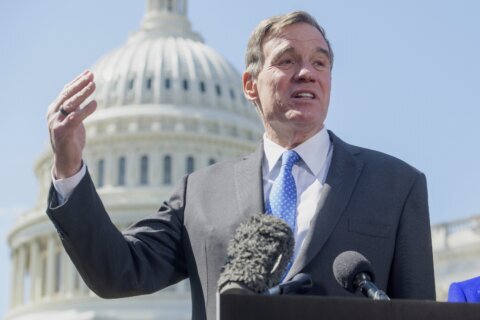This article was republished with permission from WTOP’s news partner InsideNoVa.com. Sign up for InsideNoVa.com’s free email subscription today.
This article was written by WTOP’s news partner, InsideNoVa.com, and republished with permission. Sign up for InsideNoVa.com’s free email subscription today.
OmniRide is hoping that higher fares and a larger local subsidy from its constituent localities will help make up for dwindling pandemic relief funding.
The transit agency is proposing raising fares on commuter routes from $6.90 to $9 in the next fiscal year, which starts in July. Officials say the added cost will ultimately be picked up by the federal government through employee commuter benefits for most riders.
But with rising expenses, plateauing fuels tax revenue and declining pandemic relief money, the agency is also asking for more from its localities. For Prince William County, the ask is $20.96 million, over $7 million more than in fiscal 2023.
“Cost escalation is due to labor and just general inflation,” OmniRide Executive Director Bob Schneider told the Prince William Board of County Supervisors earlier this month. “Next year, the delta is tied to the fact that the motor fuels tax is not keeping up with the cost of actual operations of service.”
In March, Keolis — the operator of OmniRide bus services — agreed to a new contract with Teamsters Local 639 after a month-long operator strike that shut down most of OmniRide’s commuter service into Washington and its inner ring. Schneider said the new contract gave the agency labor cost certainty over the next four years but means an 11% increase in those costs for the coming fiscal year.
At the same time, the federal government’s pandemic relief money is drying up for transit agencies around the country. For the current fiscal year, the bus operator was able to use $14.5 million in relief money to shore up its budget. In the coming fiscal year, it will have only $5.4 million remaining.
Expanding services
In some ways, the agency is doing better than it has during any time since the onset of the pandemic, which decimated public transit ridership. Ridership on OmniRide’s local service is actually higher than it was before the pandemic. In November 2022, for example, local service carried 2,384 trips a day and 48,883 trips per month. In November 2019, local service carried 2,074 trips per day and just under 40,000 in the month.
But commuter service has still not rebounded. In November 2022, average daily ridership on OmniRide Express buses was 4,360, down from 7,501 in November 2019.
According to Schneider, about as many individual people actually ride OmniRide commuter buses at least once a week, they just do so less frequently than they did before COVID. Back then, Schneider said, the average commuter rider took about 7½ trips per week; now they take about 3½.
And with local fares remaining free, the agency is more reliant on commuter service for its farebox revenues, but for all U.S. transit systems those revenues represent a small part of overall operating money.
Schneider said it’s a priority of the agency’s to remain fare-free for local rides, saying it was helping to attract more riders and that once the fare-collecting costs were taken into account, the difference wouldn’t be that significant.
“We take our wealthiest citizens and we transport them out of the county, and the federal government subsidizes it. Meanwhile, we have local passengers who don’t have any type of subsidy … it’s a balance of what we pay for,” he said.
To correct some of the misbalance, Schneider said, the agency is proposing to shift some commuter service hours to the local side, reducing the number of trips for some low-producing commuter routes and adding new door-to-door paratransit services on the east side of the county and a new “microtransit” zone in Quantico, Dumfries and Triangle.
The zone would look similar to the agency’s microtransit pilot on the west side of the county, in which riders can request a van pick them up from designated locations. Schneider said it’s a way to offer service in some locations where ridership isn’t so high at lower costs than traditional fixed-route lines.
Uncertain revenue picture
With the proliferation of electric vehicles, the county’s motor fuels tax revenue — which funds OmniRide and the Virginia Railway Express — is projected to remain largely flat, if not decrease, in the coming years.
The county’s department of transportation projects that by fiscal 2025, the county would need to spend roughly $15 million more than what it would take in from the fuels tax. In fiscal 2024, it’s expected to take in about $3 million less than OmniRide’s funding request.
Republicans on the Board of Supervisors questioned the agency’s spending plans, saying it needed to bring down costs.
“How in the world did things grow so exponentially in such a short amount of time?” Brentsville Supervisor Jeanine Lawson, who also sits on the Potomac and Rappahannock Transportation Commission’s board, asked Schneider. “How in the world are we practically doubling a budget need? … I would argue that the spending is what needs to change.”
But the projected growth in costs aren’t just for the same service levels, Schneider said. In future budgets, the agency wants to add more service to move residents of new housing developments and small area plan zones, like the Innovation Town Center. Essentially, it wants to follow the growth of the county’s population where it makes sense.
“We look to the future as to what’s in the [county’s] mobility plan, what’s in the county’s housing plan … and we start laying out dollars because otherwise what happens is somebody cuts a ribbon on something and we have no money to plan for it,” Schneider said.
Where the money will come from is still up in the air. The county is expected to finalize its budget next week, determining the agency’s subsidy level for fiscal 2024. Beyond that, the picture is even less clear.
Woodbridge Supervisor Margaret Franklin said she wants to see the Virginia General Assembly create a dedicated funding stream for public transportation in the state, saying it is vital to the county’s ability to meet its mobility, emissions and equity goals.
“We’re gonna have to have a very big discussion about the fund balance,” added Franklin, who also serves on the Potomac and Rappahannock Transportation Commission board. “I feel like we have to start preparing for that right now.”







